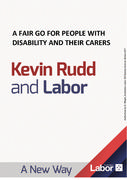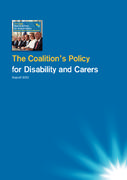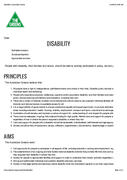
Disability policy is one of the rare areas the major parties agree on. Labor, the Coalition and the Greens all embrace supporting a national disability insurance scheme. This significant reform was prompted by a Productivity Commission inquiry that Labor initiated in 2009. It found care and support services were “unfair, underfunded, fragmented and inefficient”. In response, Labor implemented a funding scheme that is based on the individual needs of Australians with disability.
The legislation, which Parliament passed in March, provides a framework for states to roll out the funding based on eligibility criteria. The bill set up an independent agency that will work with individuals at seven launch sites across the country to determine their needs, current support and future goals. This plan determines a customised funding support package that they can choose how to manage. The first stage, costing $1 billion, will help 30,000 people with a disability by 2016. It will be partly funded by a 0.5 per cent increase in the Medicare Levy from July 2014. When fully rolled out it will support about 460,000 people with a disability.
If they win office, Labor has vowed to roll out what they have called DisabilityCare to the whole country by 2019.
If elected, the Coalition will retain the timeline and funding for the scheme. However, it will make a few minor changes. Firstly, it will broaden the scope of the joint parliamentary committee on the scheme to cover the full implementation period to 2019-20.
It will also revert to the term NDIS, arguing that many people and organisations find DisabilityCare patronising. The Greens are also committed to an ongoing and fully-funded scheme to provide lifetime care and support. However, they support extending it to those Australians who acquired a disability over the age of 65.
Apart from what has been called this “once in a life-time” reform, the parties have prioritised employment in the disability sector, supporting young carers of those with a disability and promoting advocacy. Here is what they have promised:
ALP
A Rudd government would funnel $30 million into providing 5,800 new training places over the next two years for community service workers. It would also establish a Disability Workforce National Consultative Forum to advise the government on sector needs. A national workforce strategy would be developed.
Labor would also provide $1.5 million for dedicated and specialist counsellors to work with about 1,000 young carers each year. For young people with disabilities, the party would spend $3 million to help build or upgrade about 30 playgrounds to make them accessible. It would complement this commitment with a further $1 million investment in a program called MyTime Peer Support. This network brings together 3,000 parents and carers of children with a disability through 262 groups.
The ALP has made a commitment of $1.5 million a year for disability advocacy. It would also establish a new Closing the Gap target on disability service provision for indigenous Australians. This would aim to ensure 90% of indigenous people with a disability would be covered by DisabilityCare by 2020.
The Coalition
Employment is also a focus for the Coalition who aim to reduce red tape and improve accountability and transparency. If elected, an Abbott government would cut new reporting requirements for Australian Disability Enterprises. It would also place all government programs relating to disability employment under the responsibility of one minister. The Coalition would also establish an industry advisory council that would provide advice on proposed legislation or policies that would affect the sector.
For the estimated 360,000 young carers in Australia, the Coalition focus is on ensuring their study does not suffer. The party would commit $3 million over three years to provide 150 annual bursaries. These would be valued up to $10,000 and awarded to carers under the age of 25.
The Greens
The minor party takes a rights-based approach to disability policy. Its aims are based on principles of self-determination, social participation and appropriate services. The Greens want strong and well-funded advocacy services including access to free legal services. They are also committed to community education programs to promote public awareness of disability issues.
Employment is also a feature of their policy and they want workforce improvements that provide training, development and personal support for those with a disability. The Greens have promised to double the representation of people with a disability in the public service by 2018.
The Greens have also launched an initiative that would expand the Australian Government Hearing Services program for low-income earners. They would also fund a national database to track children with a hearing impairment and provide early language and communication intervention before they started school. The Greens would also ensure sound field systems are provided in all new classrooms. They would also focus on improving hearing services in Aboriginal and Torres Strait Islander communities.




